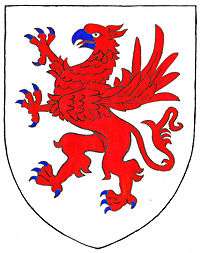Baron Botreaux

Baron Botreaux (pronounced "But'ry")[1] is a title in the Peerage of England. It was created by writ of summons in 1368 by Edward III for William de Botreaux, 1st Baron Botreaux.
In 1462, Margaret de Botreaux, 4th Baroness Botreaux, the 3rd Baron's daughter, inherited the title. She outlived both her son and grandson, so the title passed on her death to her great-granddaughter Mary Hungerford, as 5th Baroness Botreaux. Mary Hungerford married William Hastings, 1st Baron Hastings in about 1478, and their son George was created Earl of Huntingdon in 1529.
From the death of the 5th Baroness in around 1532, the title remained with the Earls of Huntingdon for 214 years. In 1746 the 9th Earl of Huntingdon died and it passed to his daughter, Elizabeth Rawdon as 16th Baroness Botreaux. Elizabeth Rawdon married John Rawdon, 1st Earl of Moira, and their son Francis was created Marquess of Hastings in 1817.
From the death of the 16th Baroness in 1808, the title remained with the Marquesses of Hastings until 1844, when it became abeyant on the death of the 4th Marquess. The abeyance was then terminated in favour of the 4th Marquess's sister Edith (who had already gained the title of 10th Countess of Loudoun through her father's death). On her death in 1874, the title passed to Edith's son, the 11th Earl of Loudoun and, as he was childless, it then passed to his niece Edith, the 12th Countess. On the 12th Countess's death in 1960, the title fell into abeyance between her daughters.
Barons Botreaux (1368)
- William de Botreaux, 1st Baron Botreaux (d. 1391)
- William de Botreaux, 2nd Baron Botreaux (d. 1392)
- William de Botreaux, 3rd Baron Botreaux (1389–1462)
- Margaret Hungerford, 4th Baroness Botreaux (d. 1477)
- Mary Hastings, 5th Baroness Botreaux (d. 1520)
- George Hastings, 6th Baron Botreaux, 1st Earl of Huntingdon (1488–1544)
- Francis Hastings, 7th Baron Botreaux, 2nd Earl of Huntingdon (1514–1560)
- Henry Hastings, 8th Baron Botreaux, 3rd Earl of Huntingdon (1536–1595)
- George Hastings, 9th Baron Botreaux, 4th Earl of Huntingdon (1540–1604)
- Henry Hastings, 10th Baron Botreaux, 5th Earl of Huntingdon (1586–1643)
- Ferdinando Hastings, 11th Baron Botreaux, 6th Earl of Huntingdon (1609–1656)
- Theophilus Hastings, 12th Baron Botreaux, 7th Earl of Huntingdon (1650–1701)
- George Hastings, 13th Baron Botreaux, 8th Earl of Huntingdon (1677–1705)
- Theophilus Hastings, 14th Baron Botreaux, 9th Earl of Huntingdon (1696–1746)
- Francis Hastings, 15th Baron Botreaux, 10th Earl of Huntingdon (1729–1789)
- Elizabeth Rawdon, 16th Baroness Botreaux (1731–1808)
- Francis Rawdon-Hastings, 17th Baron Botreaux, 1st Marquess of Hastings (1754–1826)
- George Rawdon-Hastings, 18th Baron Botreaux, 2nd Marquess of Hastings (1808–1844)
- Paulyn Rawdon-Hastings, 19th Baron Botreaux, 3rd Marquess of Hastings (1832–1851)
- Henry Rawdon-Hastings, 20th Baron Botreaux, 4th Marquess of Hastings (1842–1868) (abeyant 1868)
- Edith Rawdon-Hastings, 21st Baroness Botreaux, 10th Countess of Loudoun (1833–1874) (abeyance terminated 1871)
- Charles Clifton, 22nd Baron Botreaux, 11th Earl of Loudoun (1855–1920) (abeyant 1920)
- Edith Abney-Hastings, 23rd Baroness Botreaux, 12th Countess of Loudoun (1883–1960) (abeyance terminated 1921, abeyant 1960)
Co-heirs:
The co-heirs are the descendants of the 23rd baroness:
- Simon Abney-Hastings, 15th Earl of Loudoun (b. 1974)
- Mrs Sheena Williams (b. 1941)
- Mrs Flora Purdie (b. 1957)
- Norman Angus Maclaren (b. 1948)
Bibliography
- Maclean, Sir John, The Parochial and Family History of the Parishes of Forrabury and Minster in the County of Cornwall, 1873 (Pedigree & history of early Botreaux family)
References
- ↑ As is pronounced the name of the former Devon manor of Molland-Bottreaux, a remnant of which name survives as the hamlet of Bottreaux Mill, Molland